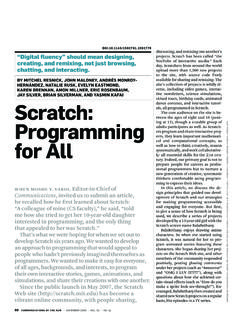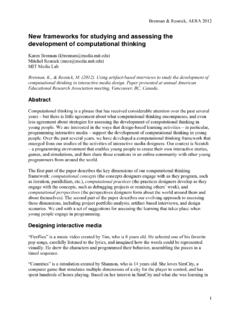Transcription of The Ripple Effect: Emotional Contagion and Its Influence ...
1 The Ripple Effect: Emotional Contagion and Its Influence on group BehaviorAuthor(s): Sigal G. BarsadeSource: Administrative Science Quarterly, Vol. 47, No. 4 (Dec., 2002), pp. 644-675 Published by: Sage Publications, Inc. on behalf of the Johnson Graduate School of Management,Cornell UniversityStable URL: .Accessed: 12/02/2015 02:13 Your use of the JSTOR archive indicates your acceptance of the Terms & Conditions of Use, available at ..JSTOR is a not-for-profit service that helps scholars, researchers, and students discover, use, and build upon a wide range ofcontent in a trusted digital archive. We use information technology and tools to increase productivity and facilitate new formsof scholarship. For more information about JSTOR, please contact .Sage Publications, Inc. and Johnson Graduate School of Management, Cornell University are collaboratingwith JSTOR to digitize, preserve and extend access to Administrative Science This content downloaded from on Thu, 12 Feb 2015 02:13:10 AMAll use subject to JSTOR Terms and ConditionsThe Ripple Effect: Emotional Contagion and Its Influence on group behavior Sigal G.
2 Barsade Yale University ? 2002 by Johnson Graduate School, Cornell University. 0001-8392/02/4704-644/$ I would like to thank Barry Staw, Charles O'Reilly, JB, Ken Craik, Jennifer Chatman, J. Turners, Batia Wiesenfeld, John Nezlek, Linda Johanson, Joe Porac, Keith Murnighan, Sara Manning, and three anonymous ASQ reviewers for their help and the positive Emotional Contagion they have induced. group Emotional Contagion , the transfer of moods among people in a group , and its Influence on work group dynamics was examined in a laboratory study of managerial decision making using multiple, convergent measures of mood, individual attitudes, behavior , and group -level dynamics. Using a 2 x 2 experimental design, with a trained confederate enacting mood conditions, the predicted effect of Emotional Contagion was found among group members, using both outside coders' rat- ings of participants' mood and participants' self-reported mood.
3 No hypothesized differences in Contagion effects due to the degree of pleasantness of the mood expressed and the energy level with which it was conveyed were found. There was a significant Influence of Emotional Contagion on individual-level attitudes and group processes. As predicted, the positive Emotional Contagion group members experienced improved cooperation, decreased conflict, and increased perceived task perfor- mance. Theoretical implications and practical ramifica- tions of Emotional Contagion in groups and organizations are discussed.* Understanding shared social processes in groups is becom- ing increasingly important as firms move toward a greater team orientation. These shared social processes can serve as a conduit for a variety of group interactions and dynamics important to getting work done. Interestingly, research on the Influence of shared social processes has focused almost exclusively on its cognitive aspects-how ideas and cognition are shared among group members.
4 This can be seen in the social-information processing literature, which focuses on how people are influenced by the cognitions and attitudes of others in their social environment ( , Salancik and Pfeffer, 1978; Bateman, Griffin, and Rubinstein, 1987; Shetzer, 1993), as well as in research examining shared social cognitions, which also focuses exclusively on the process through which people construct and share thoughts, ideas, and memories ( , Moreland, Argote, and Krishnan, 1996; Cannon-Bowers and Salas, 2001). While understanding how people share ideas adds to the knowledge of group dynamics, it does not give a complete picture. One also needs to take into account the sharing of emotions, or Emotional Contagion , that occurs in groups. The importance of emotions in organizational behavior , particularly at the individual level, has been solidly established (see Brief and Weiss, 2002, for a review), and researchers have begun to turn their attention toward understanding the processes and outcomes of collective emotion (see Barsade and Gib- son, 1998; Kelly and Barsade, 2001; George, 2002, for reviews).
5 Some theorists have gone so far as to say that "feelings may be the way group entities are known" (Sande- lands and St. Clair, 1993: 445) and that the development of group emotion is what defines a group and distinguishes it from merely a collection of individuals. Implicit attention has been paid to collective emotion in the organizational behavior literature, with many organizational processes grounded in such affective relations of group members as morale, cohesion, and rapport (Tickle-Degnen and Rosenthal, 1987). The advancement of the emotions lit- 644/Administrative Science Quarterly, 47 (2002): 644-675 This content downloaded from on Thu, 12 Feb 2015 02:13:10 AMAll use subject to JSTOR Terms and ConditionsRipple Effect erature in psychology has also allowed for a more focused and explicit examination of collective emotion.
6 George and colleagues showed that not only do group emotions exist, but these emotions, which they call group affective tone, can Influence work outcomes (George, 1989, 1990; George and Brief, 1992). In a study of senior management teams, Barsade et al. (2000) found that a group 's affective diversity, another way of conceptualizing group emotion, also had an effect on individual attitudes and team dynamics. But the question remains, what is the process by which these effects occur? While literature on shared cognitions can provide some insight into how collective emotions occur via Emotional con- tagion, there are some important differences between emo- tional and cognitive Contagion . First, the transfer of ideas is qualitatively different from the transfer of feelings. Words are central to understanding ideas yet are least important in understanding emotions, for which nonverbal cues are prima- ry (Mehrabian, 1972).
7 Because of the importance of these nonverbal cues, direct interpersonal contact is important for the transmission of emotions in groups. Conversely, sharing cognitions need not occur face to face (Ilgen and Klein, 1988). There are also some differences in the amount of effortful processing involved in cognitive and Emotional con- tagion. Although Emotional Contagion can contain elements of purposeful processing found in cognitive Contagion -such as the evaluation, interpretation, expectation, and personal goals found in the sharing of ideas (Salancik and Pfeffer, 1978)- Emotional Contagion research studies show that emo- tional Contagion most often occurs at a significantly less con- scious level, based on automatic processes and physiological responses ( , Hatfield, Cacioppo, and Rapson, 1994; Neu- mann and Strack, 2000).
8 Organizational and psychological researchers have begun to investigate the question of Emotional Contagion through field studies examining mood convergence in work teams. In a field setting, Totterdell et al. (1998) found evidence that the moods of teams of nurses and accountants were related to each other even after controlling for shared work problems. Totterdell (2000) found the same results in professional crick- et teams, controlling for the team's status in the game. In a study of meetings of 70 very diverse work groups, Bartel and Saavedra (2000) also found evidence of mood convergence. Similar to Totterdell and colleagues, Bartel and Saavedra showed that work- group mood is something that can be rec- ognized and reliably measured by members in the work group , as well as by observers external to the group . Bartel and Saavedra also examined antecedents to the mood con- vergence processes and found positive relationships between mood convergence and stable membership in the group , norms about mood regulation in the group , and task and social interdependence.
9 In Totterdell's studies, being older, along with a complex of factors related to being inter- dependent and satisfied with the team ( , more committed to the team, perceiving a better team climate, being happier and engaging in collective activity) were antecedents to mood congruence. 645/ASQ, December 2002 This content downloaded from on Thu, 12 Feb 2015 02:13:10 AMAll use subject to JSTOR Terms and ConditionsThese group mood studies offer excellent external validity that shared emotions occur in organizational work teams and can be recognized and measured, but they showed only con- current mood convergence, which makes it difficult to deter- mine causality. What remains to be done is a more causal test of Emotional Contagion and how its processes operate in groups, as well as an examination of the consequences of Emotional Contagion on group dynamics, such as cooperation and conflict, as well as on individual attitudes, cognition, and behavior .
10 A MODEL OF Emotional Contagion This study focuses on Emotional Contagion , "a process in which a person or group influences the emotions or behavior of another person or group through the conscious or uncon- scious induction of emotion states and behavioral attitudes" (Schoenewolf, 1990: 50), in particular, the Contagion of every- day moods in work groups. Similar to cognitive Contagion , Emotional Contagion is a type of social Influence (Schachter, 1959: 15; Cacioppo and Petty, 1987; Levy and Nail, 1993), and it is a process that can occur at both subconscious and conscious levels (Druckman and Bjork, 1994; Totterdell, 2000; Kelly and Barsade, 2001). What is not at all similar to cogni- tive Contagion is the content of the Contagion and, often, the processes by which it is "caught." Following Hatfield, Cacioppo, and Rapson (1994), 1 use the term emotion in this paper as a broad label, similar to that of "affect," both of which interchangeably encompass the gen- eral phenomenon of subjective feelings ( , Ashforth and Humphrey, 1995), and use literature from a variety of feeling states to understand Contagion processes, both for semantic ease and to reflect the commonality of the overall affective experience suggested by psychological researchers ( , Mayer, 1986; Forgas, 1992: 230).















